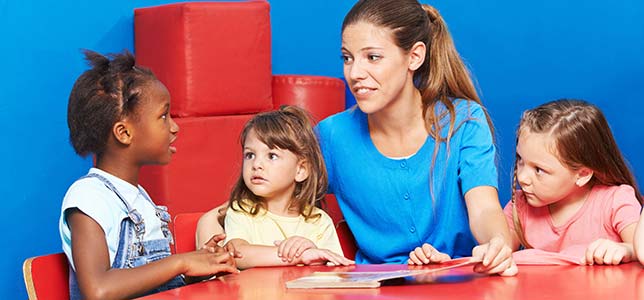Early Literacy
Conversation — Not Word Dump — Boosts Children's Brains
- By Dian Schaffhauser
- 02/27/18

Brain science has taken another leap. A joint Harvard-MIT study has discovered that it's more important to engage young children in back-and-forth conversation for developing their language skills than it is to expose them to as many words as possible. This gives a new spin on a widely publicized study from 1995 that suggested that children in higher-income families hear 30 million more words in their first three years of life than those in lower-income families, explaining significant advantages in vocabulary and language development and reading comprehension.
Researchers in MIT's Brain and Cognitive Sciences department applied functional magnetic resonance imaging (fMRI) to identify the differences in the brain's response to language and found that it correlated with the number of "conversational turns," the child was previously engaged in, as an article on the MIT website explained.
What this means, said lead researcher Rachel Romeo, a graduate student at Harvard and MIT, is that parents of any income level may influence their children's language and brain development simply by holding conversations with them. That applies to infants and toddlers as well. While the study involved children ages 4 to 6, conversations with younger children can be simulated by making sounds back and forth and making faces.
"The important thing is not just to talk to your child, but to talk with your child. It's not just about dumping language into your child's brain, but to actually carry on a conversation with them," said Romeo, whose paper, "Beyond the 30-million Word Gap: Children's Conversational Exposure is Associated with Language-related Brain Function," appeared in an online edition of Psychological Science.
The project required outfitting children in participating families with recorders for two days, from the time they awoke to the time they went to bed. A "language environment analysis" system recorded every word spoken or heard by the children. Those recordings were analyzed by an application that monitored three aspects: the number of words spoken by the child, the number spoken to the child and the number of times the child and the adult "took turns" in conversation.
That latter variable — the number of conversational turns — showed a strong link with the children's scores on standardized tests of language skill, including vocabulary, grammar and verbal reasoning. The number of conversational turns also correlated in fMRI scans with more activation in the left inferior frontal (Broca) area, tied to functions linked with speech production. According to the cognitive scientists, that correlation "significantly explained the relation between children's language exposure and verbal skill." That tie was much stronger than the one related to the number of words heard and language scores or the tie between the number of words and the activity in the Broca area.
"There's still a popular notion that there's this 30-million-word gap, and we need to dump words into these kids — just talk to them all day long, or maybe sit them in front of a TV that will talk to them," said Romeo. "However, the brain data show that it really seems to be this interactive dialog that is more strongly related to neural processing."
John Gabrieli, a professor in the Harvard-MIT Division of Health Sciences and Technology as well as the Brain and Cognitive Sciences department, and the senior author of the study, added that the "turn-taking" appears to be "the thing that makes a difference, regardless of socioeconomic status. Such turn-taking occurs more often in families from a higher socioeconomic status, but children coming from families with lesser income or parental education showed the same benefits."
The paper, he noted, "provides the first evidence that family conversation at home is associated with brain development in children. It's almost magical how parental conversation appears to influence the biological growth of the brain."
The research was funded by the Walton Family Foundation, the National Institute of Child Health and Human Development, a Harvard Mind Brain Behavior grant and a private gift.
About the Author
Dian Schaffhauser is a former senior contributing editor for 1105 Media's education publications THE Journal, Campus Technology and Spaces4Learning.